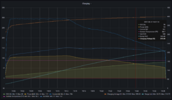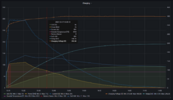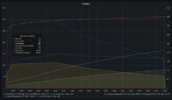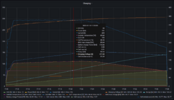Most of this really only applies to 90 packs since that is all I have data for. Also there is the whole 'charger-gate' with the 85 packs and the 100 packs have never had any kind of throttling that I have heard about but I didn't want people not to click on the thread since it's possible the heat/cooling aspect is the same for the 85 packs.
My Specs:
2016 Pre-refresh MS90D
Firmware 2021.44.6
70,000 miles
OBD and ScanMyTesla Data:
76 kWh Nominal full pack (Max range 262 miles)
DC Charge total: 6,570 kWH
AC Charge Total: 20,655 kWH
Charge Total: 34053 kWH
Regen total 6828 kWH
Charge Cycles: 447
OBD and ScanMyTesla (SMT) App
When I first got the car about 3 years ago I hit a max charge rate of 118 kWH on a v2 SuC and was pretty happy with that rate since it was around the time charger-gate details were emerging, v3 stations didn't exist yet, and I didn't know as much as I do today. Overtime I have seen this number slowly slide down to 112 kWH which is my max today:

However, looking at the charger stats of fleet data on v3 chargers (more recent data) I see that there is a large amount of people who peak about 140 kWH:

Yes, I know about low SoC, per-conditioning the pack so that it is warm so maximize the charging speed My max SoC+kWh is about 150.
My max SoC+kWh is about 150.
I was reading about people with much lower charge rates and stuck front louvers or dirty radiator (link, link) and I started thinking about things that might cause such a difference between some people getting about 20 kWH faster charging and thought it might be heat related in that that pack can't cool enough and so it throttles back the max charge rate since the cooling of the car can't keep up.
I checked my louvers and they open normally and peeked in and saw that the radiators behind them look clean and not clogged up so that wasn't a problem. I wanted to check the inside of the frunk area to check the internal parts but haven't had the time or desire to take apart the car and I kind of thought that maybe my car was just getting old and slow since my total DC charge is about the same (6,500 kW) as mentioned in a "Tesla explains why it limits Supercharging speed after high numbers of DC charges" article. Then on my most recent Supercharge session I noticed a large amount very hot air was blowing out of the driver's side wheel well and went to check the passenger side and there was a lot less air and it wasn't as hot. Maybe there is some blockage somewhere internally?
Additionally I've noticed when charging that the "BMS Max Charge" shown in SMT is more like a guideline and doesn't really come into consideration until 50% SoC so I think there is some special sauce in each firmware to tell how fast to charge above that rate maybe based on this heat dissipation rate?
My question for other MS owners:
I have attached some of my charging sessions with charging curves and other charging info. I just don't want to be taking the car on road trips and be missing out on some charging rates (i.e. time waiting) if there is something that could be done to improve rates.
Thanks for "nerding out" on charging details with me
My Specs:
2016 Pre-refresh MS90D
Firmware 2021.44.6
70,000 miles
OBD and ScanMyTesla Data:
76 kWh Nominal full pack (Max range 262 miles)
DC Charge total: 6,570 kWH
AC Charge Total: 20,655 kWH
Charge Total: 34053 kWH
Regen total 6828 kWH
Charge Cycles: 447
OBD and ScanMyTesla (SMT) App
When I first got the car about 3 years ago I hit a max charge rate of 118 kWH on a v2 SuC and was pretty happy with that rate since it was around the time charger-gate details were emerging, v3 stations didn't exist yet, and I didn't know as much as I do today. Overtime I have seen this number slowly slide down to 112 kWH which is my max today:
However, looking at the charger stats of fleet data on v3 chargers (more recent data) I see that there is a large amount of people who peak about 140 kWH:
Yes, I know about low SoC, per-conditioning the pack so that it is warm so maximize the charging speed
I was reading about people with much lower charge rates and stuck front louvers or dirty radiator (link, link) and I started thinking about things that might cause such a difference between some people getting about 20 kWH faster charging and thought it might be heat related in that that pack can't cool enough and so it throttles back the max charge rate since the cooling of the car can't keep up.
I checked my louvers and they open normally and peeked in and saw that the radiators behind them look clean and not clogged up so that wasn't a problem. I wanted to check the inside of the frunk area to check the internal parts but haven't had the time or desire to take apart the car and I kind of thought that maybe my car was just getting old and slow since my total DC charge is about the same (6,500 kW) as mentioned in a "Tesla explains why it limits Supercharging speed after high numbers of DC charges" article. Then on my most recent Supercharge session I noticed a large amount very hot air was blowing out of the driver's side wheel well and went to check the passenger side and there was a lot less air and it wasn't as hot. Maybe there is some blockage somewhere internally?
Additionally I've noticed when charging that the "BMS Max Charge" shown in SMT is more like a guideline and doesn't really come into consideration until 50% SoC so I think there is some special sauce in each firmware to tell how fast to charge above that rate maybe based on this heat dissipation rate?
My question for other MS owners:
- When supercharging at high rates is the drives side wheel well discharge air blowing at a higher temp and much faster rate than the passenger wheel well? Is this normal?
- Has anyone increased their charge rate by cleaning their raditors behind the louvers or coolant flush? It seems that people have increased their charge rate by repairing broken louvers not opening since there is a position sensor on them, but I am curious about just cleaning and increasing their air flow or changing the fluid.
- If so, do you think I should take apart the frunk and inspect the cooling? Drive to the service center so I can geo-enable the service menu and see if I can get more info? Something else in SMT that I can get more info (BMS max charge rate is not applicable)?
- Whats the max rate you are typically seeing under ideal conditions? ( Low SoC, warm pack, not sharing a v2 stall, etc. Also. please note your firmware version, mileage and additional specs if you have SMT).
I have attached some of my charging sessions with charging curves and other charging info. I just don't want to be taking the car on road trips and be missing out on some charging rates (i.e. time waiting) if there is something that could be done to improve rates.
Thanks for "nerding out" on charging details with me






